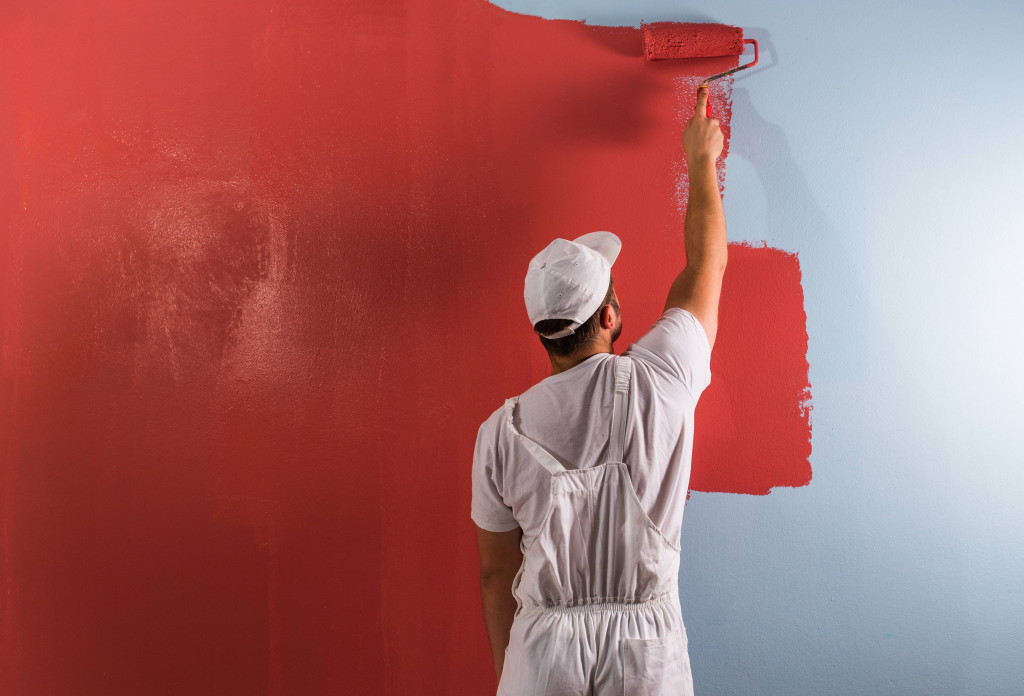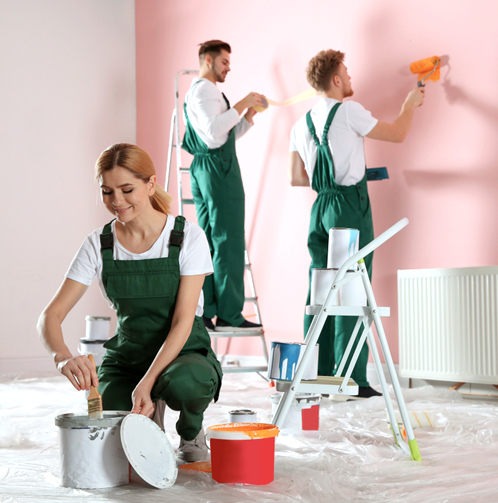Stay Ahead With New Paint Trends: Mixing Methods for Modern Interiors

The Surge of Shade Gradients in Interior Decoration
As developers progressively look for ingenious ways to enhance spaces, the surge of shade slopes in interior decoration has actually garnered significant interest. This method, identified by the smooth change between two or even more colors, permits for a dynamic visual result that can transform an ordinary room right into a vibrant setting. Color slopes can stimulate emotions, affect perceptions of space, and develop centerpieces, making them a versatile selection for various design styles.
The application of slopes expands beyond walls; they can be successfully utilized in furniture, fabrics, and devices. Designers often trying out varying tones to achieve deepness and intrigue, attracting a range of looks from minimal to eclectic. Additionally, the adaptability of slopes enables their use in both industrial and domestic settings, catering to diverse clients. As patterns advance, the usage of shade slopes represents a change in the direction of even more meaningful and personalized interior areas, mirroring specific preferences and way of lives.
Embracing Ombre Methods for a Dynamic Look
Ombre methods have actually arised as a captivating choice for those aiming to include deepness and activity to contemporary insides. This gradient impact shifts smoothly from one shade to one more, creating a visually striking centerpiece in any space. Developers value ombre for its convenience; it can be put on wall surfaces, furnishings, or even attractive accents, allowing for special expressions of style.
The technique functions especially well with soft hues, offering a serene setting, while strong colors can stimulate a space. Property owners can experiment with different color combinations, selecting different tones for a remarkable effect or harmonious tones for a refined result. The application of ombre is not limited to a single wall surface; it can expand across an area, enhancing the perception of area and light.
As a contemporary pattern, ombre techniques accommodate diverse preferences, permitting individuals to individualize their interiors and accept creativity in their style method. paint store corpus christi tx.
Textured Walls: Layering Paint for Deepness and Interest
Textured walls can considerably improve the aesthetic charm of modern-day interiors by adding depth and rate of interest. Strategies for developing structure, thoughtful shade combinations, and the right devices for layering are necessary components in achieving this result. Discovering these components enables for a customized and dynamic technique to interior decoration.
Methods for Texture Development
Producing visual interest in indoor rooms often rests on the artistic application of appearance. Numerous methods can be used to accomplish this, such as sponging, rag rolling, and stippling. Sponging involves utilizing a moist sponge to use a second color over a skim coat, developing a soft, multicolor result. Rag rolling, on the other hand, uses a rolled rag to apply paint, resulting in an extra dynamic appearance. Stippling utilizes a tight brush or tool to dab paint onto the surface, developing an one-of-a-kind pattern. In addition, layering different finishes, such as matte and glossy, can boost deepness. These methods not just give visual appeal yet likewise add to the general ambiance of modern-day insides, urging a responsive experience.
Color Mixes for Impact
Layering paint not just boosts texture however also opens a world of shade mixes that can significantly influence the mood of a room. By blending corresponding shades, developers can create a harmonious effect that welcomes heat or coolness, depending upon the wanted atmosphere. Rich earth tones combined with soft pastels can stimulate a calm atmosphere, while bold, contrasting colors can include vibrancy and energy. Additionally, including metal or shiny finishes within the layers can introduce a dynamic visual aspect, capturing light and enhancing the deepness of the shade plan. Inevitably, thoughtful color mixes via layering paint offer a chance to express specific design while changing average walls into captivating prime focus.
Tools for Layering Effect
Different tools are necessary for achieving a successful layering effect in paint applications, which can transform walls into bewitching visual experiences. Rollers and brushes are basic, with diverse dimensions permitting for different structures and coatings. Specialty tools like cloths and sponges can create one-of-a-kind patterns and deepness, while combination blades provide accuracy for more specified lines. For larger areas, using a stippling brush can include a complex coating. Additionally, spray guns can successfully use numerous layers for a smooth, even coat. Painters should additionally consider painter's tape to create clean sides between layers. By using the right devices, one can properly enhance the aesthetic allure of insides, making each wall an interesting prime focus.

The Power of Color Blocking in Modern Spaces
As modern-day interior layout proceeds to progress, color blocking becomes an effective strategy that can transform spaces with vibrant aesthetic effect. This approach involves the critical placement of contrasting shades to produce specified areas within an area, enhancing both the aesthetic allure and functionality of the room. benjamin moore paint store corpus christi. By using huge swathes of color, developers can guide the eye and highlight building components, leading to a vibrant ambience
Color blocking is not limited to wall surfaces; it can additionally be put on furnishings and design, enabling endless personalization. Matching a lively tone with a neutral tone can produce a striking focal factor while maintaining balance. This technique urges creative thinking, allowing home owners to share their personalities with one-of-a-kind shade combinations. Inevitably, shade blocking acts as an efficient method to take a breath brand-new life right into contemporary insides, making areas feel fresh, energised, and visually interesting.
Integrating Metallics for an Extravagant Finish
How can metallics boost the class of modern-day interiors? Metal surfaces act as a striking centerpiece, including depth and aesthetic rate of interest to spaces. They can change a common space into an elegant resort via the subtle interaction of light and reflection. Developers often recommend incorporating metallics in accent wall surfaces, ceilings, or furnishings to develop an elegant environment without frustrating the area.
Different metal tones-- such as silver, gold, and bronze-- provide convenience, allowing homeowners to personalize their aesthetic. A soft gold can present warmth, while a smooth silver can provide a contemporary touch. When combined with neutral tones, metallics enhance the general style, giving a sophisticated contrast that attracts the eye.
Incorporating metallic paint right into trim or moldings can likewise boost building information, producing a polished surface. Inevitably, the critical use of metallics can infuse modern insides with beauty and improvement, making them genuinely charming.
Innovative Usage of Stencils for One-of-a-kind Patterns
Changing wall surfaces with patterns can instill modern-day interiors with distinct personality and design. This artistic method permits developers and house owners to create personalized patterns that show personal aesthetic appeals. Stencils can vary from elaborate geometric styles to wayward themes, enabling a broad array of expressions. By choosing contrasting colors, stencils can boost a room's visual appeal and serve as prime focus without frustrating the area.
Furthermore, patterns are functional; they can be used to various surfaces, including walls, furnishings, and also ceilings. This versatility makes stenciling a suitable selection for DIY enthusiasts wanting to enhance their home cost effectively. Additionally, the ease of application and removal enables testing, enabling individuals to revitalize their decor with very little effort. Inevitably, creative use stencils not only transforms average surfaces but likewise gives a possibility for self-expression, making them a trending selection in modern interior decoration.
Blending Matte and Shiny Finishes for Contrast
The interaction of matte and glossy surfaces can produce a striking aesthetic dynamic in modern insides. Developers typically utilize this comparison to improve building features and specify rooms. Matte surfaces, with their soft, non-reflective high quality, can develop a sense of heat and intimacy, making them perfect for walls and larger surfaces. On check here the other hand, glossy finishes mirror light, adding vibrancy and deepness, making them appropriate for accents such as trim, moldings, or furniture.
The mix of these structures can direct the eye and emphasize prime focus within an area. Combining a matte-painted wall with glossy cabinets can produce an advanced balance. Furthermore, the mindful application of both finishes can evoke different moods while enhancing the general aesthetic. As property owners significantly seek customized rooms, blending matte and glossy coatings supplies a versatile technique to accomplishing contemporary style and aesthetic rate of interest in interior decoration.
Regularly Asked Questions
What Equipment Are Best for Mixing Paint Techniques?
A range of tools are perfect for blending paint methods, including foam rollers, brushes with soft bristles, sponge applicators, and airbrushes. Each tool offers distinct impacts, boosting the mixing procedure for different imaginative applications.
Just How Can I Take Care Of Blending Mistakes?
To fix mixing blunders, one ought to lightly sand the affected location, apply a primer if necessary, and afterwards carefully reapply paint utilizing a soft brush or sponge to achieve a smooth shift and recover the preferred impact.
Are There Specific Paint Brands Recommended for Blending?
Several paint brands are suggested for mixing, consisting of Benjamin Moore, Sherwin-Williams, and Behr. These brands use top notch coatings and a large range of colors that promote smooth changes and effective mixing methods in various indoor tasks.
Can I Blend Paint Without Specialist Help?
Yes, blending paint without specialist help is possible. With method and the right devices, people can accomplish preferable effects. Various online tutorials and guides can assist in grasping mixing techniques for personal projects.

The Length Of Time Does Blended Paint Last on Walls?
Mixed paint can last anywhere from 5 to 10 years on wall surfaces, relying on elements such as the high quality of paint used, surface prep work, and ecological problems. Regular upkeep normally boosts longevity and look.
As developers progressively seek ingenious means to improve spaces, the increase of color slopes in interior layout has gathered substantial attention. The technique functions particularly well with soft tones, giving a peaceful ambiance, while bold colors can invigorate an area. Techniques for creating texture, thoughtful shade combinations, and the right devices for layering are crucial parts in achieving this impact. Layering paint not only improves texture but additionally opens up a world of shade mixes that can significantly influence the mood of an area. As contemporary indoor design proceeds to advance, shade blocking arises as an effective method that can transform areas with strong aesthetic influence.